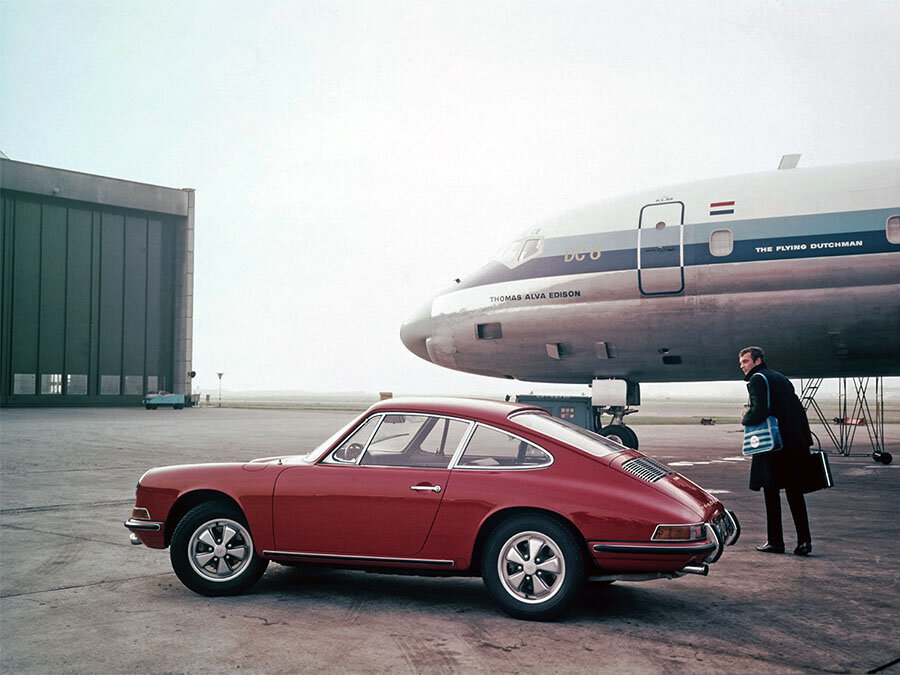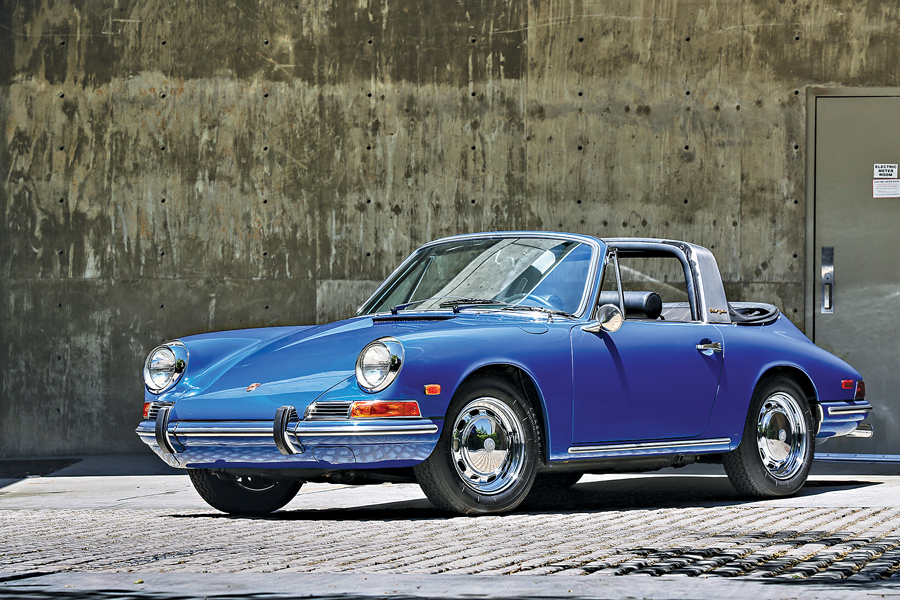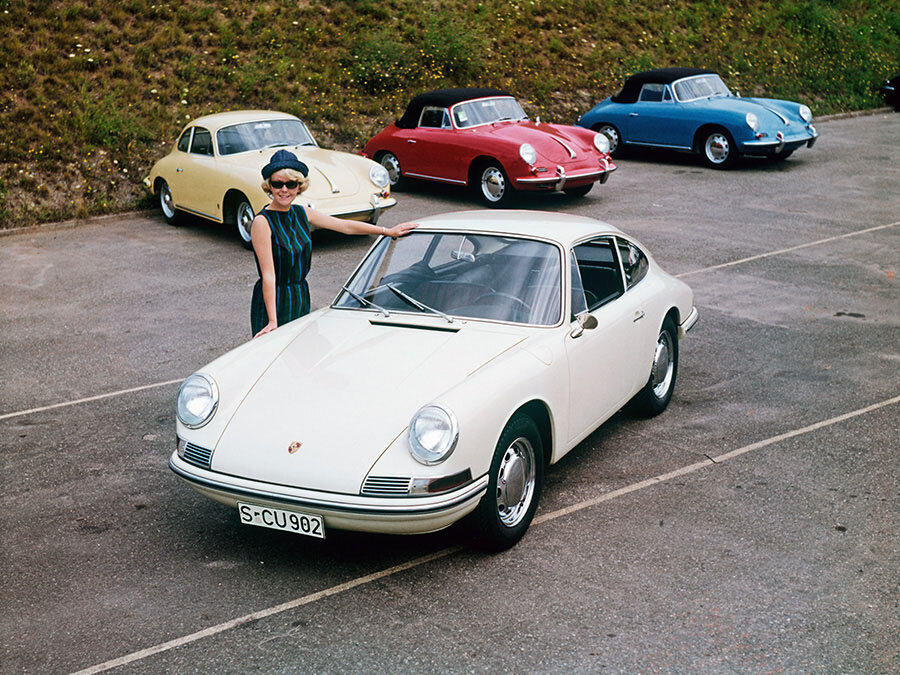(1964 – 1968) Porsche 911 2.0 (Base Model) – Ultimate Guide
2.0 O-Series “Base” 911
The Porsche 911 was developed as a replacement for the highly successful Porsche Model 356. The Porsche 911 was introduced to the world in the fall of 1963 at the Frankfurt Motor Show, as the Porsche 901 initially. This engendered a dispute with Peugeot, who held exclusive rights in the French market to three-digit model names where there was a zero in the middle. Rather than renaming the car for French consumers, Porsche simply changed the numeric designation to 911. Because production had already begun before the name was protested, 82 cars were built as 901s and the part numbers carried the 901 prefix for several years.
The Porsche 911 was larger, more powerful, more comfortable and more competitive on the track than any other comparable car on the market at the time. The original air-cooled, boxer-engined 911 was in production from 1964 through 1989 and spawned a myriad of successful variations.
The suspension layout was MacPherson strut arrangement with a single lower wishbone at the front with a fully independent back end using independent semi-trailing arm, a transverse torsion bar and telescopic shock absorber on each side. ATE disc brakes were standard as were 4.5 x 15-inch wheels and chrome hub caps.
The first edition of the 911 was built around a 130 hp, 2.0 liter, flat-six, air-cooled, rear-mounted engine. Power was 130 bhp at 6200 rpm and 128 ft lbs at 4200rpm. Transmission was via a brand new Type 901 five-speed gearbox and single-plate clutch. Porsche quoted a weight of 1030 kg, a top speed of 130 mph and 0-60 mph time of 8.3 seconds. The quarter mile time was about 16.2 seconds.
The bodywork was designed by Ferdinand ‘Butzi’ Porsche who was the son of Ferry Porsche and grandson of company founder, Ferdinand Porsche. Production began in August 1964. US deliveries started in February 1965 and the first right-hand drive examples were produced in May 1965.
Initially the 911 was only available as a Coupe. In 1967 Porsche offered their version of an open-air 911 known as the Targa. Porsche had gotten wind of a rumor that the Highway Traffic Safety Administration in the United States was going to outlaw fully open convertibles. In order to maintain the high demand for the cars in the US market, the targa model was introduced. The roof panel was removable (and foldable) starting from a stainless steel cover that housed a roll bar underneath and extending all the way forward to to the windshield header. It also included a soft canvas cover in the back with a flexible plastic window that could be removed by unzipping it. A fixed-glass wraparound rear window version of the Targa was also offered beginning in 1968. These features gave the car convertible characteristics without technically being classified as such.
O-series units were made between August 1964 and July 1967. In August 1967, the O-series 911 was replaced by the A-series numbers.
2.0 A Series “Base” 911
In August 1967, the original O-series 911 was replaced by the A-series derivative.
The 1968 model year A-series 911 was available in four basic varieties: the 911 T, the ‘normal’ 911 (here), the luxury 911 L and the sporty 911 S. All four could be ordered with Coupe or Targa. You can thank American emission legislation for the long list of variants.
The base 911 had the Type 901/06 engine and was good for 130 bhp at 6200 rpm, with 128 ft lbs of torque at 4200rpm. It had 9.0:1 compression and two Weber 40 IDA carburetors. Note, that the base 911 and 911 L destined for the USA came with Type 901/14 engines equipped with exhaust air pumps. New for this year was the addition of a 4-speed Sportomatic transmission. Sportomatic cars were equipped with just two pedals and the gearbox worked with a vacuum-controlled clutch that automatically engaged via a touch-sensitive gear lever. Base model cars equipped with Sportomatic transmission received a special engine number of Type 901/07.
The A-series 911 was discontinued in August 1968 to make way for the 1969 model year B-series variant. 1611 total coupes were produced and 521 Targas were sold of the base model. When Porsche released the B-series 911, they simplified the 911 line up by dropping the ‘base’ 911 and 911 L in favor of a new mid-range variant: the 911 E.
Porsche 911 Base Variant – Model Year Updates
1965 MY
Although Porsche began production of the 911 in late 1964, 1965 is considered the first full year of production and the formative year of the 911, with lots of changes occurring in production. The 2.0 liter engine producing 130 hp remained a constant, but small changes were made to interior and exterior components.
1966 MY
1966 was a continuation year for the first generation of the Porsche 911. With its short-Wheelbase, powered by an air-cooled, rear-mounted flat-6 “boxer” engine. It was mated to a five-speed manual “Type 901” transmission. This standard model would continue for model year 1967. However, in late 1966, Porsche introduced the more powerful 911S. As the original Solex carburetors proved difficult to keep in tune, they were dropped in favour of Weber 40 IDAs from March 1966. The new Weber-carb engines were given type number 901/05.
1967 MY
The 1967 Porsche 911 was the first to get split into two variants, the base model 911 and the more powerful 1967 Porsche 911S. The Base Model 911 featured engine Type 901/05 and Type 901/06, with Weber carburetors, rated at 130 hp. The cars produced in 1967 were the beneficiary of multiple incremental improvements, including forged valve rockers being replaced with cast iron and new gear ratios being adopted. As a result, the engine type number was changed from 901/05 to 901/06.
1968 MY
The 1968 Porsche 911 base model was available mainly in the United States and select markets. In the US, it shared the stage with the higher-trimmed 1968 Porsche 911 L (the Porsche 911 S was not available in North America that year), both powered by the same engine, Type 901/14, rated at 130 hp (some samples are believed to have Type 901/06 and Type 901/07 with Sportomatic, also rated at 130 hp). In Europe, the base model 911 was now considered the 1968 911 L, sitting between a new lower-tiered 1968 911 T and the higher-end 1968 911S. 1968 is notable as the last year of the short wheelbase 911 series. In the US, the base model 911 would become the newly introduced 1969 911T.
Pictures




















